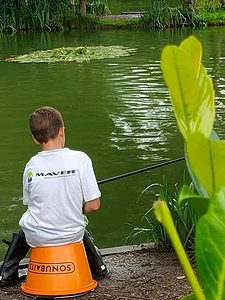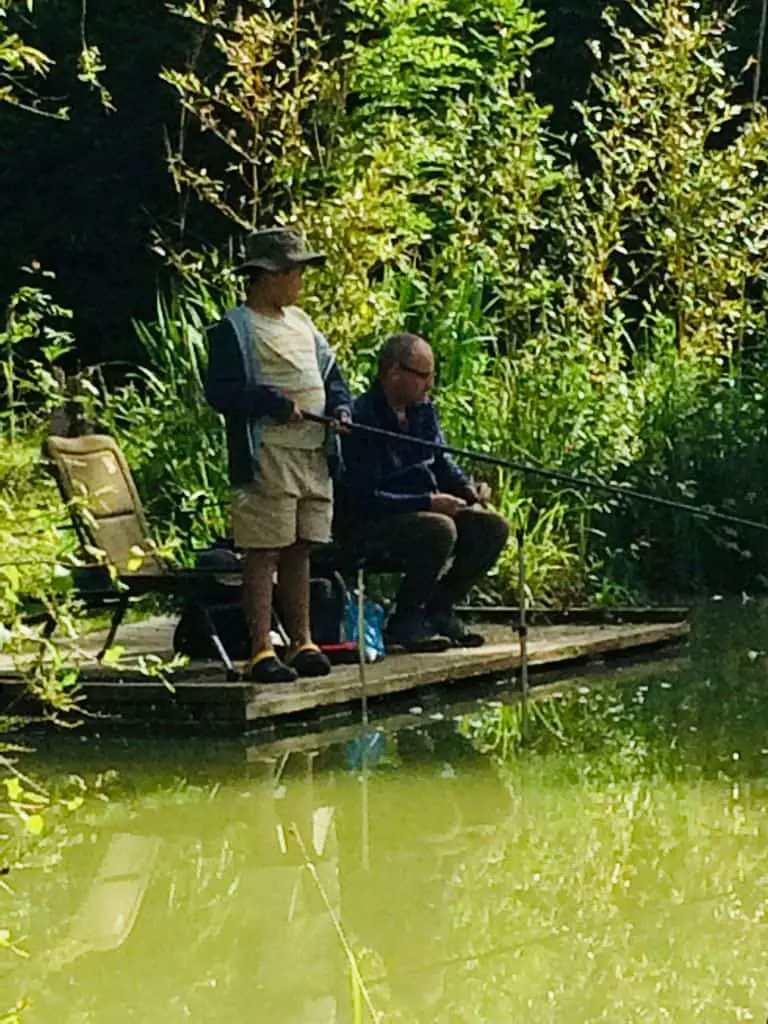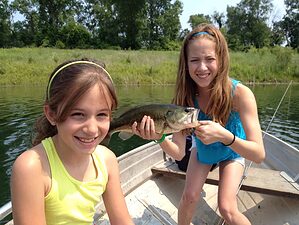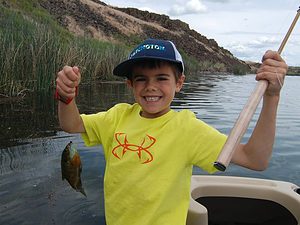Disclosure: Some posts contain affiliate links, which earn us a commission if you make a purchase through them. Positive Fishing © participates in various affiliate networks including the Amazon Services LLC Associates Program.
Now, more than ever, children spend less time outdoors. With the world of entertainment at their fingertips, one moment of solidarity or quiet can be hard for them to handle.
Parents and guardians are constantly looking for things to keep their children occupied. If you can get your child interested in fishing, you’ll provide them with a lifetime of entertainment and learning. Fishing with kids can be fun for parents and guardians, too!
Spend a free day teaching your child to fish on a lake or river and show him/her the ropes. After landing a few fish, you’ll find them asking to go back for more.
Fishing Should Be an Experience For Kids

Gone are the days when kids could sit by mom or dad and fish for hours. The entire process must be a full-on experience for them. If you look at any industry, from food to education, you’ll find that kids always have something to do to keep them preoccupied.
Start by taking your kids to a body of water with more to do than just fish. Combine fishing with swimming, nature walks, or hunting for insects. This will keep them engaged and give them other things to do while you’re waiting for fish to bite.
One of the most important things to remember is that kids aren’t going to enjoy fishing if you aren’t enjoying fishing. Kids are more perceptive than you think. They’ll mimic your emotions if they can tell you’re getting impatient or frustrated. Stay positive and keep the energy high. First impressions are vital! If the first few times fishing is fun and exciting, they’ll associate fishing with fun regardless of how many you catch.
Tip: Don’t expect to be doing much fishing yourself! The trip is about getting the kids to catch fish, NOT you!
Take Lots of Food and Drinks
Ensure you pack a cool box with all sorts of snacks and treats to keep the kids from getting hungry or thirsty. Before you leave home, let them choose and pack the goodies.
Tip: Taking plenty of water with you is necessary; fishing on a hot sunny day makes everyone thirsty.
Check The Weather Before Take the Kids Fishing
Wherever possible, we want to go in the best weather. Kids will not be keen to return if it’s raining all day. Just check the weather forecast the day before you plan to go.
Tip: Choose the right clothing for the trip, and pack an extra jacket in case it gets cold.
Go Where Kids Are Sure To Catch Fish

Your kids will want to do the most “catching” possible. If you can, time your fishing excursion with the prime feeding hours of the day. This will give you the best chance to help them land a fish and see why it’s enjoyable.
Tip: Go to a location that you already know well and are familiar with the types of fish and the places to catch them.
Also, go to productive waters and target fish that aren’t going to be overly picky. Taking your children out and targeting carp or catfish on their first fishing trip may not be your best idea! Target perch, panfish, or small bass. They’re usually willing to feed, and you have the excitement of landing an extremely aggressive fish.
Tip: Whilst fishing, always make sure safety is put first. The water can be dangerous. Fishing tackle, such as hooks, can cause injury if incorrectly handled.
Start Kids With the “Fun” Parts of Fishing
Again, it’s all about the experience with your kids. Diehard anglers find different parts of the sport to be “fun.” However, remember that you’re dealing with a child and must try to show them the fun sides of fishing.
Show them how to bait and set the hook and teach them to cast out their bobber.
Teaching them how to “read the water” or sit patiently could cause them to lose interest. The more stimulating you can be initially, the more willing they’ll be to sit through even the slower fishing days.
Tip: Take a break occasionally, and walk together down the river bank or around the lake for a few minutes.
Learning To Spin Fish Is The Easiest Method
Even if you enjoy other types of fishing, it’s best to start your kids by learning spin fishing. Buy them their own coarse fishing starter kits, which have all the basic gear they will need, and make them something they’re responsible for caring for. This will provide even more interest!
If you love fly fishing or ice fishing, don’t start them at that level. Start them simple even if it’s fishing from a dock or the shore. With spin fishing, you’ll find they can do more independently, and you don’t have to watch over them constantly!
Let the Kids Bait the Hook
Kids will always have fun with most types of bait; start them using the most common fishing bait. If they are squeamish about handling maggots or worms and don’t like touching them, use artificial plastic bait at first.
By baiting up plastic baits (especially worms), they will get a good experience of baiting the hook, which will help them learn once they are ready to use the real bait!
Tip: Always take as many pictures as you can of the fish the kids catch, and it will give that extra motivation to go more often.
How to Teach Kids to Cast
Consider their motor skills when you’re trying to teach kids how to cast. Most kids can start casting around four or five years old. They can communicate and complete the majority of the necessary motions for casting.
Teaching kids to cast is going to require an extreme amount of patience on your end. They’ll mess up, get in tangles, and likely appear as if they’re never going to learn.
- You first need to ensure that they have the appropriate size gear. Don’t feel bad if you have your kid start on a cheap spinning rod from a local box store. They’ll quickly outgrow it, but they’ll learn the motion, and it won’t break the bank.
- You’ll find that most children’s rods have an underspin reel. Underspin reels have a nice line-release trigger. Teach your child to hold the line-release trigger long enough to let their line hit the water. It’s an easy action and not challenging to teach.
- Start casting in the yard at home, away from the water. The water is so exciting and stimulating that they may not focus or learn the necessary movements.
- Determine what hand your child will reel with and ensure it’s set up properly. Once you have this setup, tie on a small weight or “plug” and let you start teaching.
- Have the child hold the rod over their shoulder, get ready to collapse the line trigger, and whip it over their shoulder. They must collapse the line trigger by bringing the rod over their shoulder. This will allow the line to escape the reel and cast.
- You want the rod tip to finish right near their shoulder. The bait will barely leave the rod’s tip and smack the water if it finishes too low.
Start To Fish Where There Are Lots Of Fish

Once your kids know how to cast, you can bring them to the water. Start on a smaller pond or lake with plenty of open space so you won’t have to deal with any obstacles that make life challenging. The more trees and weeds you can avoid, the better you’ll be.
Make sure you head to the water during the time of day when the fish are going to bite! This will help them put the casting techniques they learned to good use. The more action, the more they’ll learn to love fishing.
You can up the challenge once you start seeing your kids gain confidence. Take them on your boat, a kayak, or a canoe. Or go to a small river or stream and see what fish you can find. As you up the challenge, you’ll find that kids will become more focused in hopes of impressing you and practicing everything you have learned.
Tip: Take a hat and sunscreen if you know it will be hot and sunny.
If The Fishing Is Slow, Give the Kids Simple Jobs To Do
This can range from looking out in the water for any moving fish to even looking around at nature.
Tackle boxes are typically very messy; mine could always be done with rearrangement or sorting. Kids are great at doing these tasks. More importantly, keep them occupied, and they will feel like they are helping out.
Tip: During the trip, teach them fishing etiquette. Remain quiet, take home all the garbage, be gentle with the fish, and respect all fish, whether big or small.
Tips for When Kids Get Discouraged or Get Bored Fishing

Odds are you’ll find a kid or two that doesn’t fall in love with fishing. It could be the weather, the lack of action, or the work that goes into preparing for it that causes them to lose interest, but that’s okay!
Whether you decide they should keep trying is up to you, but it’s important to know what to do when they lose interest.
- Be okay with failure; find joy in it! We all struggle when we fish, which makes it special. Do your best to make it fun and keep a good attitude, as you may fail. Even if you have to show them how to do something 50 different times, keep patient and do your best to show that it’s the reality of fishing.
- Encourage your kids as much as possible! Kids don’t want to disappoint their parents or guardians. If you want to turn a kid off to fishing, get frustrated with them while they’re trying to learn something you love to do! Remember that it took time for you to learn as well.
- Embrace and help your kids to find some fishing sites on social media. There are plenty of YouTube channels with younger people who fish! The Googan Squad is a great resource for young anglers with instructional videos and family-friendly content. A simple search on YouTube Fishing will provide thousands of fun videos.
- Invite some of your kids’ friends along! Sometimes, learning with a friend can create more interest for your children. If anything, they’ll have someone to talk to as they learn! You can consider that a win if they’re outside enjoying themselves.
Last Important Tip: Be patient, and don’t get frustrated! Kids will tangle up the line, make too much noise, and sometimes complain. As mentioned earlier in this article, encourage, encourage, encourage!
Buy Them A Rod And Reel Combo Fishing Set
Once they have been fishing a couple of times, consider getting them their own fishing rod and reel combos set. These sets are great birthday or Christmas fishing presents, and once they have their own fishing rod and reel, they will show even more interest.
Final Thoughts
Kids these days need affirmation, stimulation, and positive adult role models. Fishing is a great activity to teach dozens of life lessons.
It’s no secret that the outdoors is healing. People have been returning to them forever in hopes of finding true peace. Take the opportunity to teach your kids to fish, and they’ll have plenty of time to prepare themselves for life.
Let’s do our part and show kids how great the sport is. It’ll inspire them to continue learning and make for more patient and happier kids. Continue reading more about fishing for beginners in my category focused on learning the sport.
- 5 Best Fishing Bags For Getting Your Gear Organized - January 13, 2025
- 4 Essential Surf Fishing Rigs - January 11, 2025
- How To Know The Sex Of A Fish You Have Caught? - December 9, 2024
